Ostatnio jeden z naszych czytelników zapytał nas, jak wyświetlać podrzędne strony strony WordPress? Jest to pytanie, które dość często otrzymujemy w WPBeginner i podkreśla powszechną potrzebę poprawy nawigacji na stronie i doświadczenia użytkownika.
Jeśli organizujesz swoją witrynę WordPress za pomocą stron nadrzędnych i podrzędnych, możesz chcieć wyświetlić swoje strony podrzędne lub podstrony na głównej stronie nadrzędnej. Pomaga to użytkownikom łatwo zobaczyć wszystkie informacje dostępne w określonej sekcji i szybko przejść do odpowiednich podtematów.
Możesz również chcieć wyświetlić link do głównej strony nadrzędnej na każdej podstronie, aby ułatwić przeglądanie, tworząc efekt podobny do okruszków chleba. Ta usprawniona nawigacja zapobiega zagubieniu się użytkowników w głębi Twojej witryny i poprawia ich ogólne wrażenia z przeglądania.
W tym artykule pokażemy Ci, jak łatwo wyświetlić listę stron potomnych dla strony nadrzędnej w WordPress.
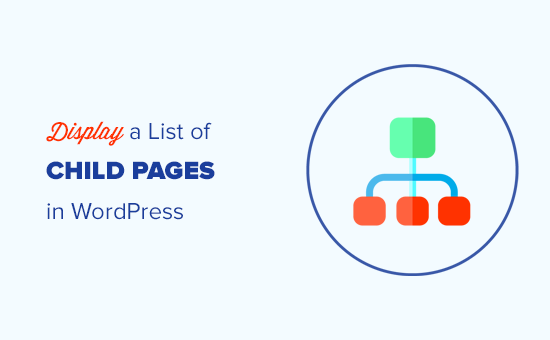
Kiedy potrzebujesz pokazać listę stron potomnych?
WordPress posiada dwa domyślne typy wpisów: wpisy i strony. Wpisy to treść bloga i zazwyczaj są organizowane za pomocą kategorii i tagów.
Strony to jednorazowe lub samodzielne treści, które są ponadczasowe, takie jak na przykład strona „O nas” lub „Kontakt”.
W WordPressie strony mogą być hierarchiczne, co oznacza, że można je organizować za pomocą stron nadrzędnych i podrzędnych. Na przykład, możesz chcieć utworzyć stronę Produkt z podstronami Funkcje, Cennik i Wsparcie.
Aby utworzyć podstronę, postępuj zgodnie z naszym przewodnikiem jak utworzyć podstronę w WordPress.
Po utworzeniu stron nadrzędnych i podrzędnych możesz chcieć wyświetlić podrzędne strony na głównej stronie nadrzędnej.
Teraz łatwym sposobem jest ręczna edycja strony nadrzędnej i dodanie listy linków indywidualnie.
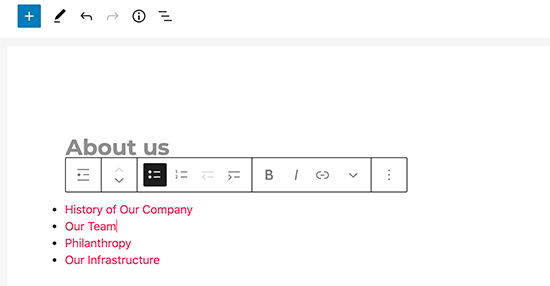
Jednak będziesz musiał ręcznie edytować stronę nadrzędną za każdym razem, gdy dodasz lub usuniesz podstronę.
Czy nie byłoby miło, gdybyś mógł po prostu utworzyć stronę potomną, a ona automatycznie pojawiłaby się jako link na stronie nadrzędnej?
Biorąc to pod uwagę, przyjrzyjmy się kilku innym dynamicznym sposobom szybkiego wyświetlania listy stron podrzędnych na stronie nadrzędnej w WordPressie. Pokażemy trzy metody, dzięki czemu możesz wybrać tę, która jest dla Ciebie najlepsza:
- Metoda 1. Wyświetlanie podstron na stronie nadrzędnej za pomocą wtyczki
- Metoda 2. Wyświetlanie podrzędnych stron dla strony nadrzędnej za pomocą kodu
- Metoda 3. Dynamiczne wyświetlanie podstron bez żadnego shortcode'u
Metoda 1. Wyświetlanie podstron na stronie nadrzędnej za pomocą wtyczki
Ta metoda jest najłatwiejszym sposobem wyświetlania podstron na stronie nadrzędnej i jest zalecana dla wszystkich użytkowników.
Najpierw musisz zainstalować i aktywować wtyczkę Page-list. Więcej szczegółów znajdziesz w naszym przewodniku krok po kroku na temat jak zainstalować wtyczkę WordPress.
Po aktywacji musisz edytować stronę nadrzędną i po prostu dodać następujący krótki kod tam, gdzie chcesz wyświetlić listę stron podrzędnych.
[podstrony]
Możesz teraz zapisać swoją stronę i wyświetlić jej podgląd w nowej karcie przeglądarki. Zauważysz, że wyświetla prostą listę punktowaną wszystkich podstron.
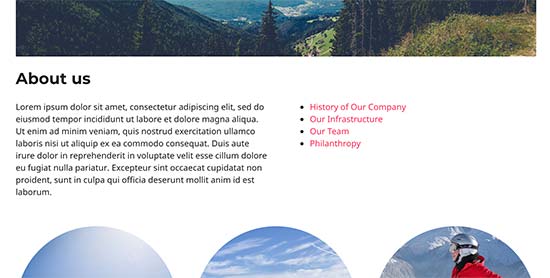
Jeśli chcesz, możesz dodać trochę niestandardowego CSS, aby zmienić wygląd listy.
Oto przykładowy kod CSS, którego możesz użyć jako punktu wyjścia.
ul.page-list.subpages-page-list {
list-style: none;
list-style-type: none;
background-color: #eee;
border: 1px solid #CCC;
padding: 20px;
}
Po zastosowaniu niestandardowego CSS możesz podglądnąć stronę nadrzędną.
Tak to wyglądało na naszej testowej stronie WordPress:
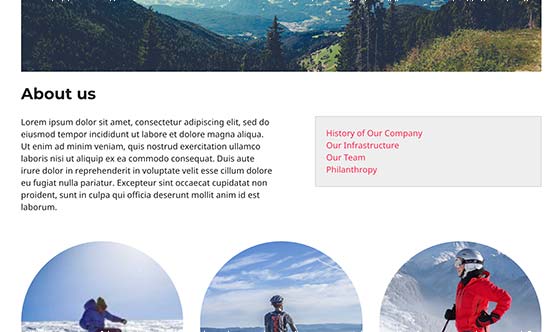
Wtyczka udostępnia wiele parametrów skróconego kodu, które pozwalają ustawić głębokość, wykluczyć strony, liczbę elementów i wiele więcej.
Szczegółowe informacje można znaleźć na stronie wtyczki, gdzie znajduje się szczegółowa dokumentacja.
Metoda 2. Wyświetlanie podrzędnych stron dla strony nadrzędnej za pomocą kodu
Ta metoda jest nieco zaawansowana i wymaga dodania kodu do Twojej strony WordPress. Jeśli nie robiłeś tego wcześniej, zapoznaj się z naszym przewodnikiem na temat jak kopiować i wklejać kod w WordPressie.
Aby wyświetlić podstrony pod stroną nadrzędną, musisz dodać następujący kod do wtyczki fragmentów kodu lub do pliku functions.php swojego motywu:
function wpb_list_child_pages() {
global $post;
if ( is_page() && $post->post_parent )
$childpages = wp_list_pages( 'sort_column=menu_order&title_li=&child_of=' . $post->post_parent . '&echo=0' );
else
$childpages = wp_list_pages( 'sort_column=menu_order&title_li=&child_of=' . $post->ID . '&echo=0' );
if ( $childpages ) {
$string = '<ul class="wpb_page_list">' . $childpages . '</ul>';
}
return $string;
}
add_shortcode('wpb_childpages', 'wpb_list_child_pages');
W WPBeginner zawsze zalecamy dodawanie kodu w WordPressie za pomocą wtyczki WPCode.
WPCode pozwala łatwo dodawać niestandardowy kod bez edycji plików motywu, dzięki czemu nie musisz się martwić o uszkodzenie swojej witryny.
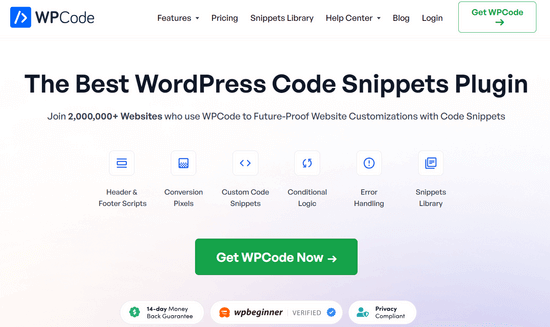
Najpierw musisz zainstalować i aktywować bezpłatną wtyczkę WPCode. Szczegółowe instrukcje znajdziesz w tym przewodniku jak zainstalować wtyczkę WordPress.
Po aktywacji wtyczki przejdź do Fragmenty kodu » Dodaj fragment z panelu administracyjnego WordPress.
Stamtąd najedź kursorem myszy na opcję „Dodaj swój niestandardowy kod (nowy fragment)” i kliknij przycisk „Dodaj niestandardowy fragment”.
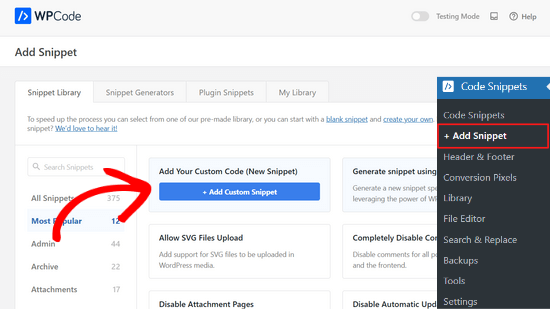
Następnie musisz wybrać „PHP Snippet” jako typ kodu z listy opcji, które pojawią się na ekranie.
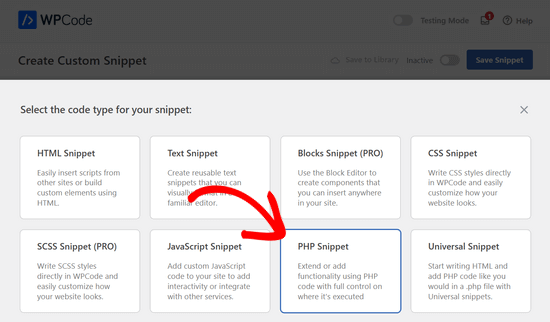
Następnie dodaj tytuł dla swojego fragmentu, który może być czymkolwiek, co pomoże Ci zapamiętać, do czego służy kod.
Teraz po prostu wklej powyższy kod do pola „Podgląd kodu”.
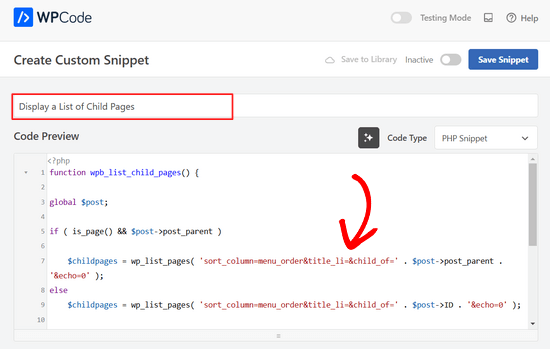
Następnie po prostu przełącz przełącznik z pozycji „Nieaktywny” na „Aktywny” i kliknij przycisk „Zapisz fragment” u góry strony.

Ten kod najpierw sprawdza, czy strona ma rodzica, czy sama strona jest rodzicem.
Jeśli jest to strona nadrzędna, wyświetla powiązane z nią podrzędne strony. Jeśli jest to strona podrzędna, wyświetla wszystkie inne podrzędne strony swojej strony nadrzędnej.
Na koniec, jeśli jest to po prostu strona bez podrzędnej lub nadrzędnej strony, kod po prostu nic nie zrobi. W ostatniej linii kodu dodaliśmy skrót, dzięki czemu można łatwo wyświetlać podrzędne strony bez modyfikowania szablonów stron.
Aby wyświetlić podstrony, wystarczy dodać następujący shortcode do strony lub widżetu tekstowego w pasku bocznym:
[wpb_childpages]
Nie zapomnij zapisać zmian i wyświetlić ich podgląd w karcie przeglądarki. Tak to wygląda na naszej stronie testowej.
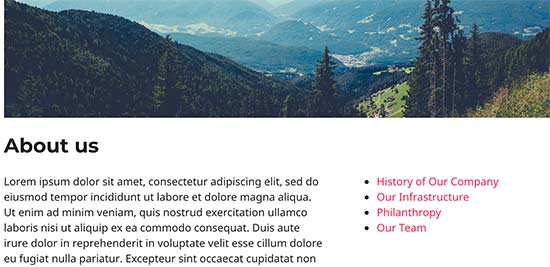
Możesz teraz stylizować tę listę stron za pomocą niestandardowego CSS.
Oto przykładowy kod CSS, którego możesz użyć jako punktu wyjścia:
ul.wpb_page_list {
list-style: none;
list-style-type: none;
background-color: #eee;
border: 1px solid #CCC;
padding: 20px;
}
Metoda 3. Dynamiczne wyświetlanie podstron bez żadnego shortcode'u
Używanie shortcode'ów jest wygodne, ale problem z nimi polega na tym, że będziesz musiał dodawać shortcode'y do wszystkich stron, które mają strony nadrzędne lub podrzędne.
Możesz mieć shortkody na wielu stronach, a czasem możesz nawet zapomnieć o ich dodaniu.
Lepszym podejściem byłoby edytowanie pliku szablonu strony w motywie, aby mógł automatycznie wyświetlać podrzędne strony.
Aby to zrobić, musisz edytować główny szablon page.php lub utworzyć niestandardowy szablon strony w swoim motywie.
Możesz edytować swój główny motyw, ale te zmiany znikną, jeśli zmienisz lub zaktualizujesz swój motyw. Dlatego lepiej byłoby, gdybyś utworzył motyw potomny, a następnie wprowadził zmiany w motywie potomnym.
W pliku szablonu strony musisz dodać tę linię kodu tam, gdzie chcesz wyświetlić podstrony.
<?php wpb_list_child_pages(); ?>
To wszystko. Twój motyw automatycznie wykryje strony podrzędne i wyświetli je w prostej liście.
Style można dostosować za pomocą CSS i formatowania.
Oto przykład, jak strona OptinMonster pokazuje stronę nadrzędną i podstrony:

Mamy nadzieję, że ten artykuł pomógł Ci w tworzeniu listy podstron dla strony nadrzędnej w WordPressie. Możesz również zapoznać się z naszym przewodnikiem na temat najważniejszych stron do utworzenia na nowej stronie WordPress, oraz naszym porównaniem najlepszych kreatorów stron WordPress typu przeciągnij i upuść do tworzenia niestandardowych układów bez żadnego kodu.
Jeśli podobał Ci się ten artykuł, zasubskrybuj nasz kanał YouTube po samouczki wideo WordPress. Możesz nas również znaleźć na Twitterze i Facebooku.





Philip
Cześć, to działa, z tym że rodzic też się wyświetla, jak pokazać tylko strony podrzędne, dzięki
Wsparcie WPBeginner
Najprostszym rozwiązaniem tego, czego wydajesz się chcieć, byłoby nie umieszczanie treści na stronie nadrzędnej, a jedynie w podrzędnych stronach.
Admin
Sachit Shori
Dziękuję bardzo. Uratowałeś mnie.
Wsparcie WPBeginner
You’re welcome
Admin
Emmanuel Husseni
Witaj Wpbeginner,
Proszę, jak mogę posortować wszystkie strony podrzędne alfabetycznie na stronie nadrzędnej. Przeszedłem wszystkie kroki, ale podstrony są wyświetlane losowo na stronie nadrzędnej.
Czekam na odpowiedź. ….Dzięki
Wsparcie WPBeginner
Zmienilibyśmy dwie instancje menu_order w naszym kodzie na: post_title
Admin
Iyke O.
Jak sprawić, aby lista była zwijana na pasku bocznym.
Wsparcie WPBeginner
Aby uczynić ją zwijaną, możesz użyć wtyczki akordeonu, takiej jak jedna z naszych artykułów tutaj: https://www.wpbeginner.com/showcase/best-wordpress-accordion-plugins/
Admin
Stacie
Łatwe do naśladowania i zadziałało. Wielkie dzięki za udostępnienie!
Wsparcie WPBeginner
You’re welcome, glad our content could be helpful
Admin
Aaro
Czy mogę przypisać klasę CSS do tej funkcji? Tak, aby zmiany CSS w elementach ul nie wpływały na inne ul na stronie.
Lub jakieś inne proste rozwiązanie tego problemu?
Wsparcie WPBeginner
You could add your CSS class in the ul section of the function
Admin
Keshav Murthy
Witaj, Zespół WPB,
Bardzo dziękuję za ten fragment i samouczek.
Oszczędziło mi to mnóstwo czasu i pomogło mi.
Z wyrazami szacunku,
Keshav Murthy
Wsparcie WPBeginner
Glad our tutorial could help
Admin
Gary Granai
Zainstalowałem wtyczkę code snippets w wordpress 4.9.8
Skopiowałem kod na https://www.wpbeginner.com/wp-tutorials/how-to-display-a-list-of-child-pages-for-a-parent-page-in-wordpress/#respond i dodałem go do nowego fragmentu w fragmentach kodu.
Utworzyłem stronę, a następnie stronę, której przypisano pierwszą stronę jako stronę nadrzędną.
Relacja między stroną nadrzędną a podrzędną jest pokazana na liście stron w rozwijanym menu atrybutów.
Kiedy otwieram stronę nadrzędną, nic nie pokazuje, że jest strona podrzędna.
Następnie spróbowałem użyć strony functions.php.
Dodałem kod skopiowany z https://www.wpbeginner.com/wp-tutorials/how-to-display-a-list-of-child-pages-for-a-parent-page-in-wordpress/#respond na dole kodu na stronie funkcji.
Kiedy otwieram stronę nadrzędną, nie wyświetla się. Wyświetla się komunikat o błędzie mówiący o nieoczekiwanym kodzie.
Przywróciłem stronę functions.php do jej pierwotnego stanu.
Jakie zmiany muszę wprowadzić w tym, co próbowałem zrobić.
Wsparcie WPBeginner
Cześć Gary,
Upewnij się, że opublikowałeś podstronę przed przetestowaniem kodu. Ponadto dokładnie skopiuj kod ponownie, aby upewnić się, że nie kopiujesz liczb ani żadnych nieoczekiwanych znaków.
Admin
Itika
Mam pytanie. Dodałem podstrony do strony nadrzędnej, ale kiedy otwieram stronę na telefonie i klikam na stronę nadrzędną, otwiera się pusta strona nadrzędna. Aby zobaczyć rozwijane podstrony, trzeba przytrzymać przycisk strony nadrzędnej. Jak mogę to naprawić? Nie chcę, aby otwierała się ta pusta strona. Chcę, aby po dotknięciu strony nadrzędnej otwierało się menu rozwijane.
Proszę o sugestie, jak to zrobić.
Denise
Dla stron trzeciego poziomu (wnuków), chcę pokazać to samo menu, które widać na stronach dzieci (wszystkie linki dzieci rodzica). Za pomocą tego fragmentu kodu, będąc na stronie wnuka, widzę tylko inne strony wnuków w menu. Jak ten kod musiałby zostać zmodyfikowany, aby pokazać wszystkie linki dzieci, nawet gdy jesteśmy na stronach wnuków?
wika
jak uzyskać identyfikatory stron podrzędnych, a nie stron wnuków... proszę o pomoc, jestem początkujący
Meredith L
Jestem stosunkowo nowy w blogowaniu i niedawno przeszedłem na motyw Kale Wordpress. Próbowałem tworzyć strony atrybutów strony (pod stroną nadrzędną Przepisy), aby mieć oddzielne kategorie dla przystawek, deserów itp. Wszystko wydaje się przechodzić w części administracyjnej, ale potem na samej stronie nie ma atrybutów strony/rozwijanych menu z kategorii Przepisy. Co robię źle? Wszystko jest ustawione jako publiczne, więc nie jestem pewien, na czym polega problem.
Daves
Dziękuję za ten kod. Ale nie chcę, aby był wyświetlany na stronie głównej (statycznej), tylko na stronach nadrzędnych. Jak można to zrobić?
Dziękuję.
Boris Budeck
Używam motywu Generatepress (stworzyłem motyw potomny, aby go dostosować) i nie mogę sprawić, żeby to działało. Krótki kod jest wyświetlany na stronie wyjściowej, wygląda na to, że nawet nie jest rozpoznawany jako krótki kod. Używam widżetów Elementora i nie działają ani widżety tekstowe, ani widżety krótkich kodów.
Czy jest jakiś sposób, aby to działało przy użyciu widżetów Elementora?
Wsparcie WPBeginner
Cześć Boris,
Spróbuj dodać ten kod do pliku functions.php swojego motywu lub do wtyczki specyficznej dla witryny.
add_filter('widget_text', 'do_shortcode');1-click Use in WordPress
Admin
Frederic
świetny post, to jest dokładnie to, czego szukałem od wielu godzin! i działa jak marzenie, wystarczy dodać kod do pliku function.php motywu, a następnie dodać krótki kod na stronie, gdzie chcę, aby pojawiły się podstrony, i voila!!!
Cudownie, wielkie dzięki za twoją hojność!!
Wsparcie WPBeginner
Cześć Frederic,
Glad you found it useful You may also want to subscribe to our YouTube Channel for more WordPress video tutorials.
You may also want to subscribe to our YouTube Channel for more WordPress video tutorials.
Admin
Mariano
Cześć!
Dzięki za kod. Jak mogę wyświetlić wyróżniony obrazek każdej podstrony?
Ron
Podobnie jak w przypadku wielu znalezionych fragmentów kodu, trzeba przejrzeć wszystkie komentarze, aby zadziałało. Co jest nie tak z testowaniem tego, co piszesz?
Alicia
Czy można zrobić menu rozwijane dla stron nadrzędnych/podrzędnych na wordpress.com, czy musi to być wersja .org?
Razvan
Co jeśli chcę wyświetlić podrzędne posty, a nie podrzędne strony?
Rudy
Użycie tego kodu powoduje wyświetlanie strony nadrzędnej wraz ze stronami podrzędnymi, co jest zbędne. Z tego co rozumiem, tak naprawdę potrzebujemy wyświetlać tylko strony podrzędne, a nie stronę nadrzędną. Czy są jakieś sugestie modyfikacji, które mogą to zrobić?
Michael Feske
Great, but it works not
czy add_shortcode jest poprawne, czy raczej add_filter https://www.wpbeginner.com/wp-tutorials/how-to-use-shortcodes-in-your-wordpress-sidebar-widgets/ ?
z add_shortcode jest błąd Fatal error: Uncaught Error: Call to undefined function add_shortcode()
z add_filter nie ma błędu, ale nie działa
Milos
Podczas aktualizacji wtyczek, z jakiegoś dziwnego powodu zawsze otrzymuję błąd:
Fatal error: Cannot redeclare wpb_list_child_pages() (previously declared in …/wp-content/themes/pagelines/functions.php:25) in …/wp-content/themes/pagelines/functions.php on line 34
Jeffrey Fry
Jak można również wyświetlić datę strony podrzędnej?
ethann
Witaj, świetny artykuł,
Czy możesz mi pomóc w stworzeniu listy rozwijanej stron podrzędnych na stronie nadrzędnej. Potrzebuję tej funkcjonalności do jednego z moich projektów na WordPressie i jestem zupełnym nowicjuszem w WordPressie.
Alex
Czy jestem jedynym, któremu to nie działa?
Mam następującą strukturę
O nas
— Strona 1
— Strona 2
— Strona 3
Będąc na stronie "O nas" lub na stronie dziecka (1, 2 lub 3) chciałbym mieć listę z moją stroną rodzica ("O nas") i wszystkimi dziećmi (1, 2, 3) – Czy komuś udało się to zrobić?
Thanks!
Kendra
OMG, przepraszam, to jest irytujące. Proszę zignoruj moje inne posty. Nie zdawałem sobie sprawy, że nie można wklejać kodu do komentarzy.
NIE udało mi się sprawić, żeby to działało z wpb_list_child_pages();
Udało mi się to uruchomić za pomocą echo do_shortcode( '[wpb_childpages]')
A aby uzyskać tytuł strony nadrzędnej, wstawiam to powyżej listy stron podrzędnych:
$current = $post->ID;
$parent = $post->post_parent;
$grandparent_get = get_post($parent);
$grandparent = $grandparent_get->post_parent;
PHP if ($root_parent = get_the_title($grandparent) !== $root_parent = get_the_title($current)) {echo get_the_title($grandparent); }else {echo get_the_title($parent);
Jean Bishop
Używam tego kodu i działa świetnie. Czy jest możliwe, aby wyświetlać również kategorie w menu obok stron?
Michelle
Cześć,
Chcę zrobić następujące rzeczy
Strona nadrzędna musi być na sprzedaż i/lub do wynajęcia
Następnie chcę, aby dziecko, na przykład prowincja (Gauteng), linkowało do strony nadrzędnej na sprzedaż i do wynajęcia.
Jak mam to zrobić?
Michelle
Zakhar
Jak mogę utworzyć skrócony kod z parametrem, na przykład [wpb_childpages id="1"], gdzie id="1" to identyfikator strony nadrzędnej?
Strand
Cześć,
Czy można ograniczyć liczbę linków do określonej liczby, na przykład maksymalnie 12 stron podrzędnych?
Dzięki
Aander
Dziękuję,
Czy możesz wyjaśnić, proszę, jak mogę zorganizować podrzędne strony w liście rozwijanej, która byłaby dostępna przez stronę nadrzędną? (Nie chcę, aby odwiedzający widzieli wszystkie podrzędne strony w formie blogrolla.)
Tj. na stronie nadrzędnej chcę utworzyć listę rozwijaną (listbox), do której strony podrzędne byłyby dodawane w predefiniowanej kolejności (np. alfabetycznie). Po przeczytaniu Wprowadzenia odwiedzający może przejść dalej, wybierając dowolną stronę z listy według własnego uznania (strony podrzędne nie mają logicznego powiązania, więc w każdym przypadku będzie szukał dokładnej strony).
Czy „mój sen” jest możliwy do zrealizowania?
Jeszcze raz dziękuję.
Quantum-mecha
Jak dodać paginację dla strony podrzędnej?
Dzięki!
Astrid
Witaj zespole WPBeginner,
Użyłem kodu, który podaliście z opcją „short code” i zadziałało (linki do stron podrzędnych). Jednak chciałem użyć opcji „permanent”, a to nie zadziałało.
Kiedy dodałem tę linię kodu [ ] strona nadrzędna zwraca błąd 500 i żadne strony podrzędne nie są w ogóle wyświetlane.
Co robię źle?
Przy okazji, jeśli chciałbym wyświetlić fragment z odpowiednim obrazkiem, jak bym to zrobił? Dzięki!
Astrid
Udało mi się to rozwiązać.
Dodałem fragment kodu, a następnie dodałem ten krótki kod [wpb_childpages] do strony nadrzędnej, gdzie chciałem, aby wyświetlały się strony podrzędne. Niesamowite!
Czy w celu wyświetlenia fragmentów i obrazka użyłbym tych samych zapytań – tak samo jak posty w kategorii.
Thanks in advance
Jade
Hej, zastanawiałem się, co miałeś na myśli mówiąc 'query'? Jak dokładnie uzyskałeś wyświetlanie fragmentów i obrazków na stronie rodzica?
Dzięki!
Mehar
Naprawdę przydatne. Dziękuję.
Pradeep
Czy ktoś mógłby potwierdzić, czy strona przykładowa użyta w tym samouczku http://optinmonster.com/how-it-works/ wykorzystuje tę funkcję, czy nie? Moim zdaniem wygląda to tak, jakby używali zakładek zamiast podstron.
Jeśli dobrze rozumiem, czy ktoś mógłby skierować mnie do zasobu, aby uzyskać tę funkcję, ponieważ desperacko szukam płynnego rozwiązania, takiego jak to, które mają na tej stronie?
Wielkie dzięki,
Pradeep
Andrew Roberts
W przypadku opcji innej niż krótki kod, możesz poinformować użytkowników, że muszą albo zmienić
return $string;naecho $string;, albowyświetlić w szablonie strony funkcję
echo page_list_child_pages();Podziękowania dla Erika za wskazanie tego powyżej
Meredith Adams
Dziękuję!
Gaby
Dziękuję! Zastanawiałem się, dlaczego kod nie działał...
Howard
Cześć, udaje mi się to uruchomić, gdy odwiedzam moją domenę z podkatalogiem (np. example.com/home), ale podczas przeglądania strony bez tego (example.com) lista podstron nie jest wyświetlana. Czy ktoś może mi wskazać, gdzie popełniam błąd?
Z góry dziękuję – jestem bardzo nowy w WordPressie.
Emily Jennewein
Jak sprawić, aby ta funkcja wyświetlała stronę nadrzędną na górze listy wraz z listą stron podrzędnych i wnuków? Na stronach podrzędnych nie wyświetla strony nadrzędnej.
Michael
jak mogę to dostosować, aby wyświetlać tylko podstrony konkretnej strony?
Yester
Jak dodać klasę 'active' do bieżącego elementu?
Jenny
Czy jest teraz wtyczka, która może zrobić to samo?
a także czy możemy zdecydować, gdzie znajdzie się pole z podmenu stron, w dowolnym obszarze strony, a nie tylko na górze strony? Używanie wtyczki
Zespół WPBeginner
Tak, można go używać do niestandardowych typów postów. Tak jak tutaj:
function wpb_list_child_pages() {
global $post;
if ( 'movie' == get_post_type() && $post->post_parent )
$childpages = wp_list_pages( 'post_type=movie&sort_column=menu_order&title_li=&child_of=' . $post->post_parent . '&echo=0' );
else
$childpages = wp_list_pages( 'post_type=movie&sort_column=menu_order&title_li=&child_of=' . $post->ID . '&echo=0' );
if ( $childpages ) {
$string = '' . $childpages . '';
}
return $string;
}
add_shortcode('wpb_childpages', 'wpb_list_child_pages');
Daniela
To świetnie! Czy jest sposób, aby zrobić to samo dla niestandardowych typów postów, które mają posty podrzędne?
Caroline
Również się zastanawiam!
Jeśli ktoś wie, proszę o pomoc!
dpc
Czy jest sposób, aby to zmodyfikować w celu drukowania niestandardowych typów postów podrzędnych na stronie niestandardowego typu postu? Dzięki, jest to bardzo przydatne!
Sokeara
To dla mnie bardzo świetne! Tak czy inaczej, chciałbym wiedzieć, jak mogę wyświetlić tytuł i miniaturę strony podrzędnej na stronie nadrzędnej.
Ashley Bell
Cześć, mam to samo pytanie. Naprawdę podoba mi się styl listy na stronie Beginners Blueprint, ale nie mam pojęcia, jak zacząć. Czy ktoś może polecić artykuł do przeczytania lub udzielić jakiejś rady, dzięki.
Razvan Zamfir
Cześć!
Miły fragment, ale jak wyświetlić tylko strony potomne?
Dziękuję!
amitabha197
Wystąpił błąd na stronach, które nie mają podstron, więc lekko zmodyfikowałem
if( count($childpages) != 0 ) {
$string = ” . $childpages . ”;
}
zamiast
if( $childpages ){
$string = ” . $childpages . ”;
}
Zespół WPBeginner
Aby wykonać shortcode w szablonach WordPress, musisz dodać go w następujący sposób:
Matt Rock
Nie udało mi się sprawić, żeby kod szablonu „wpb_list_child_pages();” działał, ale echo shortcode zadziałało. Pozdrawiam!
Erik
Po prostu zmień „return $string” na „echo $string” (to wydrukuje strony).
fariha
dzięki, zadziałało
Coen Siebenheller
Dodałem kod do pliku functions.php i kiedy dodaję skrócony kod [wpb_childpages] do mojego tekstu, działa. Ale kiedy próbuję dodać go do jednego z moich szablonów, nic się nie pokazuje. Czy ktoś wie, co robię źle?
Elena Rapisardi
Świetne wyjaśnienie!!
Czy jest sposób, aby zawsze wyświetlać strony nadrzędne?
Quin
To jest genialne, dzięki.
Czy jest sposób, aby to dostosować, aby strona nadrzędna wyświetlała wnuki, a nie dzieci?